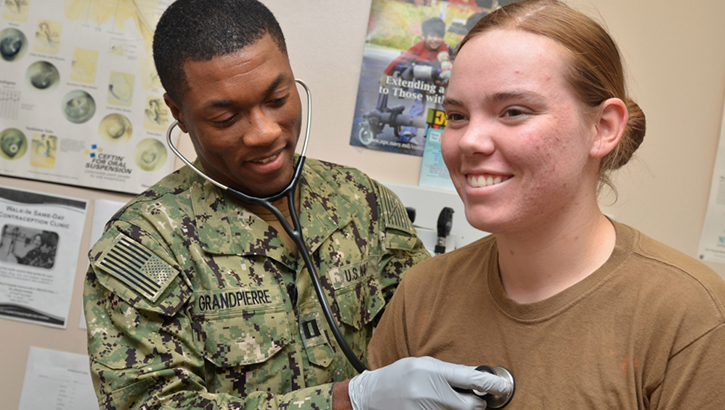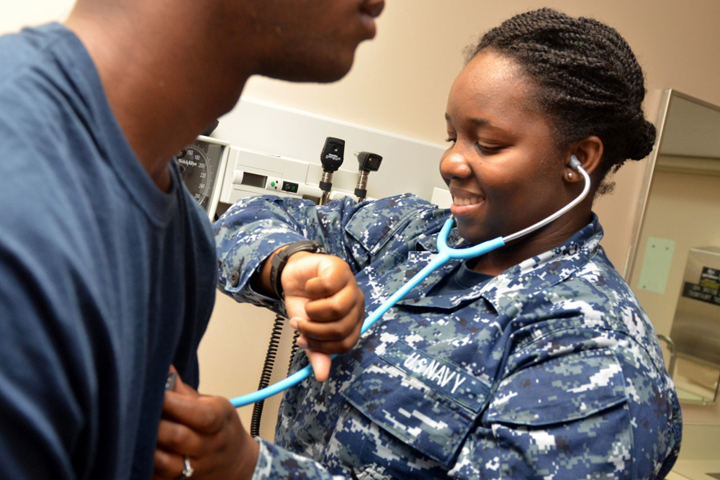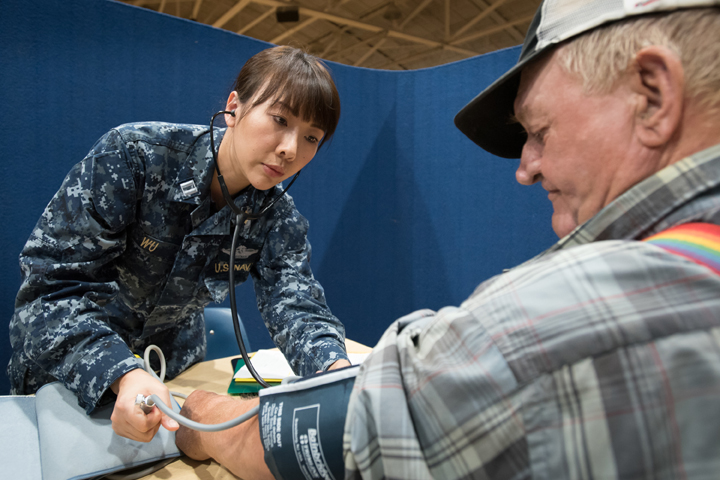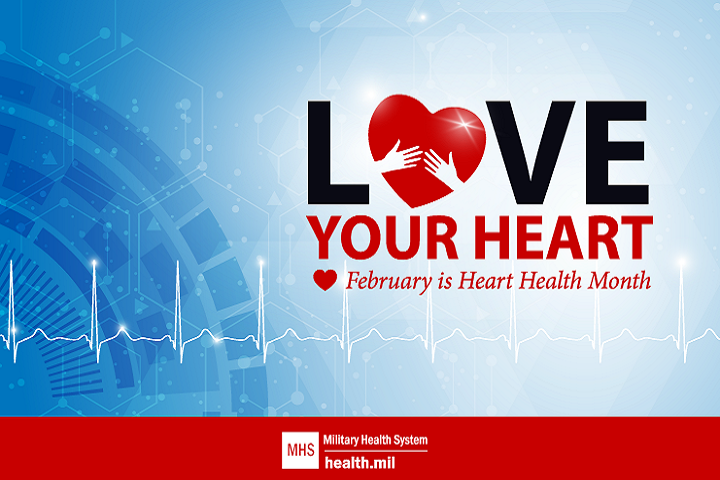
Listen to your heart in February with Total Force Fitness

Navy Lt. Karl Yves Marie Grand Pierre, a physician assistant at Naval Branch Health Clinic Kings Bay, Georgia, checks Seaman Ashley Jackett’s heart. DoD recommends that all service members and beneficiaries do just that: listen to your heart and build healthy heart habits. (U.S. Navy photo by Jacob Sippel, Naval Hospital Jacksonville)
Blood runs through every service member defending the country, every civilian supporting their mission, and every family member and friend who loves them. Having a medically ready force for the Department of Defense means paying attention to the organ that pumps this blood: the heart.
This is American Heart Month, which gives the Military Health System the chance to look at the heart and how to take care of it. Heart disease is the No. 1 cause of death among men and women in the United States, so good heart habits are key to quality of life.
“A healthy heart is important for military readiness and peak performance,” said Patricia Deuster, Ph.D., director of the Consortium for Health & Military Performance at the Uniformed Services University for Health Sciences.
DoD’s Total Force Fitness framework supports heart health through focus on eight fitness domains. Habits in physical, medical, nutritional, and even financial fitness can affect the heart.
Obesity, diabetes, smoking, and high blood pressure are common concerns for the military. They are also among the risk factors for heart disease. Service members and their families are advised to look at current lifestyle and use the Total Force Fitness framework to build healthy habits.
“Certain things you can't change, like your age, sex, or family history,” Deuster said. “But many risk factors can be changed, so paying attention to them can improve your chances of keeping your heart healthy.”
Older people are more likely to have heart attacks and blocked arteries. However, Deuster says that many habits people have as children and young adults can affect heart health as they get older.
“Children will mimic adults either by example or out of necessity,” Deuster said. “Adults, parents, and leaders need to set the example for children, young adults, and service members.”
Focus on Total Force Fitness can show how diet, exercise, and managing stress affect heart health. People who already have heart disease are more likely to develop other health problems. Deuster suggests starting healthy habits early.
“The sooner in life you do so, the sooner you will be investing in your future heart health,” she said.
Stay tuned through the month to see how the MHS is addressing heart health and tips to keep the body’s strongest organ healthy
MHS raises awareness of heart health on National Wear Red Day
Article
2/4/2020

Dress for success (a healthy heart) Friday Feb. 7
Is exercise that’s too intensive resulting in your angina?
Article
4/8/2019

Angina is experienced as a feeling of tightness or pressure in the chest that can also radiate out to your neck, jaw, back or shoulders
Sudden cardiac death in young athletes
Article
3/7/2019

Sudden cardiac events can occur in seemingly healthy young people in their teens or twenties, including young servicemembers
Too much pressure: Hypertension a leading cause of heart disease
Article
3/5/2019

Healthy lifestyle now can help prevent disorder later
Focus on heart-healthy diet is perfect fit for February
Article
2/22/2019

With the typical American diet and lifestyle, many people put themselves at risk for developing various heart diseases
Taking care of your heart with TRICARE benefits
Article
2/19/2019

Getting preventive screenings now could save your life tomorrow
Deep vein thrombosis: What you need to know
Article
4/9/2018

Everyone’s potentially at risk, vascular surgeon says
Small changes, big results: Healthy lifestyle choices can make a difference for heart health
Article
4/6/2018

Risk for heart disease, the number one killer of Americans every year, can be decreased through healthy lifestyle and nutrition choices
Parents and doctors watch over a tiny heart
Article
3/19/2018

A military family’s rocky medical road with congenital heart disease
Focus on prevention … not the cure for heart disease
Article
2/21/2018

Many heart health problems can be avoided
Absolute and Relative Morbidity Burdens Attributable to Various Illnesses and Injuries, Active Component, U.S. Armed Forces, 2016
Infographic
6/19/2017

This infographic documents healthcare burdens attributable to cardiovascular diseases among active component, U.S. Armed Forces in 2016.
Heart Disease and Its Effects on Service Members
Infographic
6/8/2016

Cardiovascular disease comprises disorders of the heart and circulatory system including coronary heart disease and cerebrovascular disease. This infographic provides data on the risk factors for cardiovascular disease among military members base on diagnostic codes in the electronic health records of service members during a 10-year surveillance period.
The ABC's of Heart Health
Infographic
2/22/2016

Bring awareness to the risks of heart disease and ways to stay heart healthy.
Take Charge of Your Heart Health
Infographic
2/16/2016

Take Charge of Your Heart Health with Regular Checkups
Keep Your Heart Healthy This Valentine's Day
Infographic
2/11/2016

4 ways to keep your heart healthy this Valentine's Day
No comments:
Post a Comment